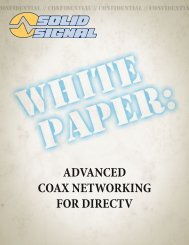Owner's Guide to Installation and Use - Stark Electronics
Owner's Guide to Installation and Use - Stark Electronics
Owner's Guide to Installation and Use - Stark Electronics
You also want an ePaper? Increase the reach of your titles
YUMPU automatically turns print PDFs into web optimized ePapers that Google loves.
IMPORTANT SAFEGUARDS<br />
Your antenna rota<strong>to</strong>r unit, consisting of a control <strong>and</strong> a drive, has been engineered <strong>and</strong> manufactured<br />
<strong>to</strong> assure your personal safety, but improper installation or abuse of this unit, or the antenna connected<br />
<strong>to</strong> it, can result in potential electrical shock or fire hazards. In order not <strong>to</strong> defeat the safeguards<br />
incorporated in this unit, observe the following basic rules for its installation, use <strong>and</strong> servicing.<br />
1. An outside antenna system should not be located in the vicinity of overhead power lines or other<br />
electric light or power circuits, or where it can fall in<strong>to</strong> such power lines or circuits. When installing<br />
an outside antenna system, extreme care should be taken <strong>to</strong> keep from <strong>to</strong>uching such power lines<br />
or circuits as contact with them might be fatal.<br />
2. If the drive unit is installed on an outdoor antenna, be sure the antenna system is grounded so as<br />
<strong>to</strong> provide some protection against voltage surges <strong>and</strong> built-up static charges. Section 810 of the<br />
National Electrical Code, ANSI/NFPA70, or CSA C22.1 Sections 10, 16, <strong>and</strong> 54, of the Canadian<br />
Electrical Code, provides information with respect <strong>to</strong> proper grounding of the mast <strong>and</strong> supporting<br />
structure, grounding of the antenna lead-in wire <strong>and</strong> drive-unit <strong>to</strong> control-unit interconnecting cables<br />
<strong>to</strong> an antenna discharge unit, size of grounding conduc<strong>to</strong>rs, location of antenna-discharge unit,<br />
connection <strong>to</strong> grounding electrodes, <strong>and</strong> requirements for the grounding electrode. See separate<br />
enclosed grounding code on page 26.<br />
3. Your control is provided with ventilation openings <strong>to</strong> allow heat generated during operation <strong>to</strong> be<br />
released, If these openings are blocked, heat build-up can cause failure of the control <strong>and</strong> external<br />
damage. Therefore:<br />
• Never block the ventilation slots by placing it on a bed, sofa, rug, etc.<br />
• Never place in a “built-in” enclosure unless proper ventilation is provided;<br />
• Never cover the openings with cloth or other material;<br />
• Never place near or over radia<strong>to</strong>rs, heat registers, amplifiers, or other heat sources.<br />
4. Your control may be equipped with a polarized AC line plug (one blade of the plug is wider than<br />
the other). This safety feature allows the plug <strong>to</strong> fit in<strong>to</strong> the power outlet only one way. Should you<br />
be unable <strong>to</strong> insert the plug fully in<strong>to</strong> the outlet, try reversing the plug. Should it still fail <strong>to</strong> fit,<br />
contact your electrician <strong>to</strong> replace your obsolete outlet. Do not defeat the safety purpose of the<br />
polarized plug.<br />
5. Operate the control only from an A.C. power source as indicated on the bot<strong>to</strong>m of the control.<br />
Do not use D.C.<br />
6. Overloaded AC outlets <strong>and</strong> extension cords are dangerous, <strong>and</strong> so are frayed power cords <strong>and</strong><br />
broken plugs. They may result in a shock or fire hazard. Unplug the control <strong>and</strong> call your service<br />
technician for replacement.<br />
7. Do not allow anything <strong>to</strong> rest on or roll over the power cord, <strong>and</strong> do not place the control where<br />
power cord is subject <strong>to</strong> traffic or abuse. Pay particular attention <strong>to</strong> the cord at the plug <strong>and</strong> the point<br />
where it exists from the control unit. This may result in a shock or fire hazard.<br />
8
















